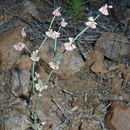en
names in breadcrumbs


Seeds of Davidson's wild buckwheat were pounded into a meal and eaten dry by the Kawaiisu people of southern California (M. L. Zigmond 1981).
Eriogonum davidsonii is a species of wild buckwheat known by the common name Davidson's buckwheat. This plant is native to the southwestern United States and northern Baja California.[1] It grows in sandy or gravelly soils, mixed grassland, saltbush, chaparral, sagebrush communities as well as oak and montane conifer woodland.[2] It is a spindly annual herb growing up to 40 centimeters in height. Leaves are fuzzy, basal, and round with wavy or wrinkly margins fuzzy. They are two centimeters wide. The plant is variable in appearance, but is usually erect with thin, naked, neatly branching stems bearing clusters of tiny flowers at widely spaced nodes. Each flower is about 2 millimeters wide, bell-shaped, and can be white, pink or red. Flowering occurs May to September.[1][2]
Eriogonum davidsonii is a species of wild buckwheat known by the common name Davidson's buckwheat. This plant is native to the southwestern United States and northern Baja California. It grows in sandy or gravelly soils, mixed grassland, saltbush, chaparral, sagebrush communities as well as oak and montane conifer woodland. It is a spindly annual herb growing up to 40 centimeters in height. Leaves are fuzzy, basal, and round with wavy or wrinkly margins fuzzy. They are two centimeters wide. The plant is variable in appearance, but is usually erect with thin, naked, neatly branching stems bearing clusters of tiny flowers at widely spaced nodes. Each flower is about 2 millimeters wide, bell-shaped, and can be white, pink or red. Flowering occurs May to September.